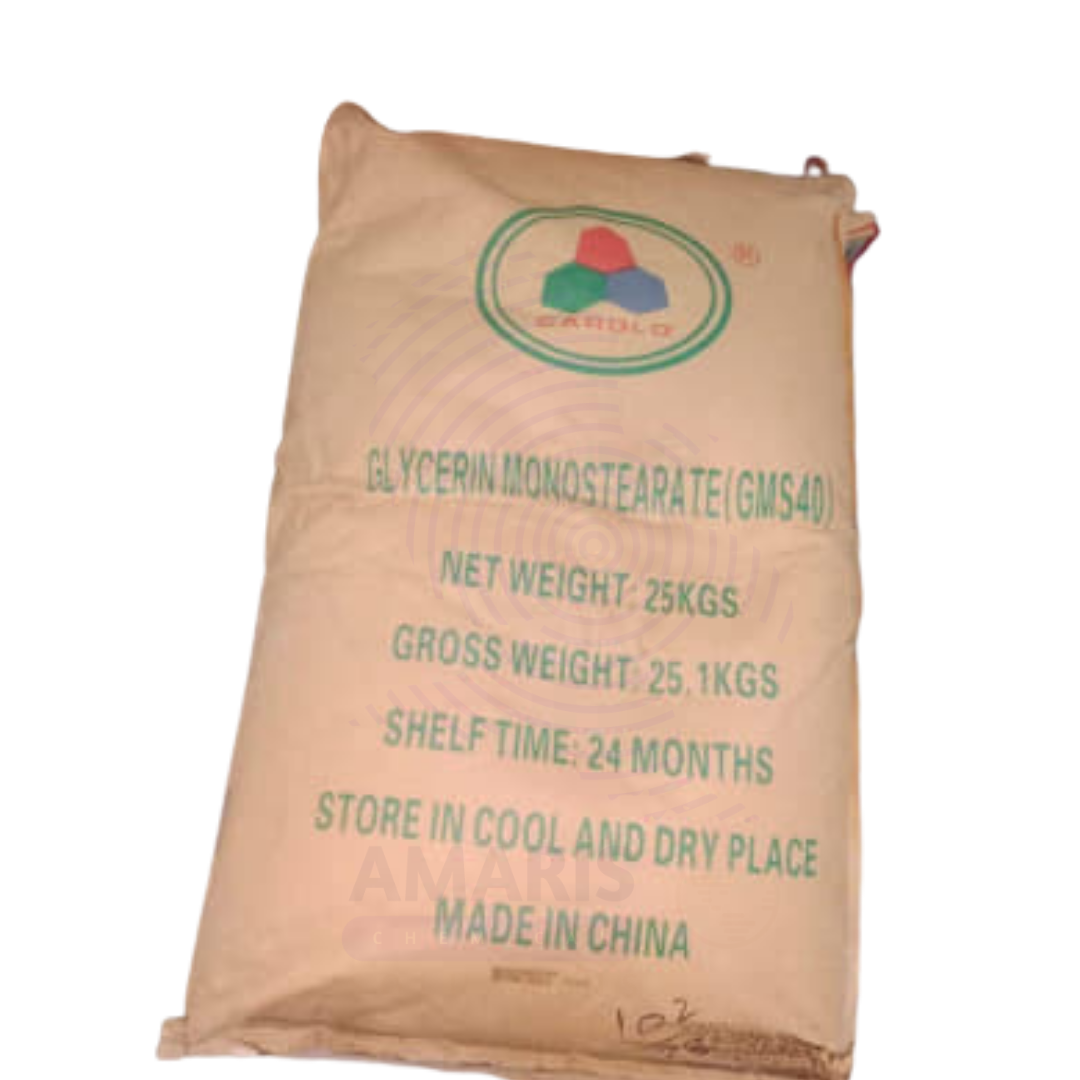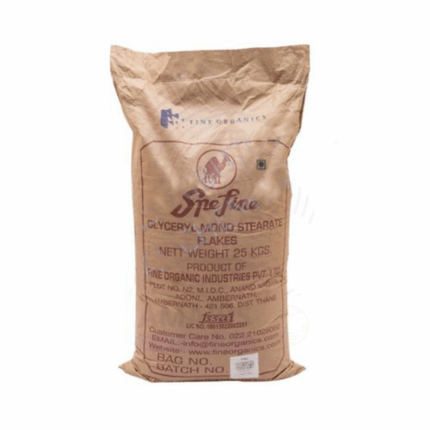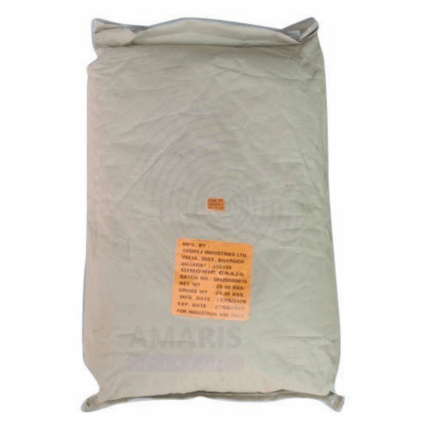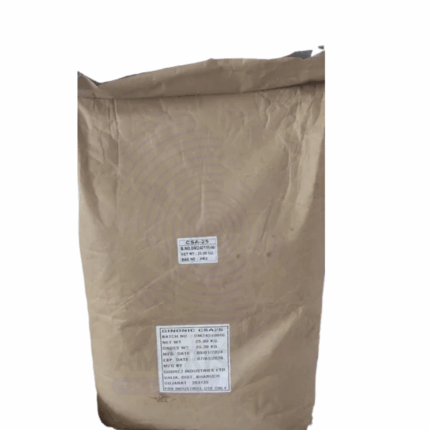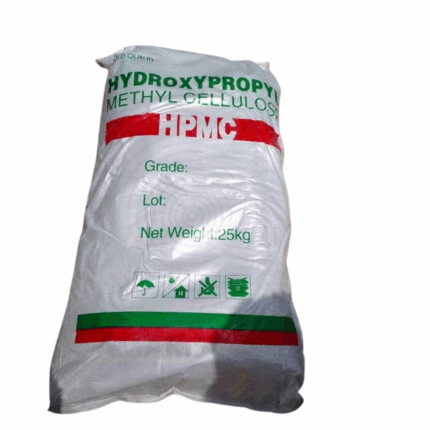
Glycerol Monostearate Powder
$ 3.00 Original price was: $ 3.00.$ 2.67Current price is: $ 2.67.
Glycerol Monostearate Powder is a white to off-white, free-flowing powder composed of 50% monoglycerides of stearic and palmitic acids, typically derived from vegetable oils. It is a non-ionic emulsifier widely used in food, cosmetics, pharmaceuticals, plastics, and industrial applications. GMS functions as an emulsifying agent, stabilizer, thickener, anti-staling agent, and opacifier. In food, it improves texture and extends shelf life. In cosmetics and pharmaceuticals, it enhances creaminess and stability. GMS 50% is often blended with other emulsifiers or surfactants and is valued for its versatile functionality, safety, and compatibility with a wide range of ingredients.
Glycerol Monostearate Powder
Primary Uses
- Food Industry
- Emulsifier in margarine, peanut butter, creamers, and spreads to maintain stable oil-water mixtures.
- Anti-staling agent in bread and baked goods; enhances softness, improves crumb structure, and extends shelf life.
- Aerating agent in whipped toppings, ice cream, and bakery creams, improving volume and texture.
- Texturizer and thickener in sauces, processed cheese, and instant pudding mixes.
- Release agent in bakery applications to prevent sticking of dough or batter to molds and pans.
- Fat replacer in reduced-fat food products.
- Stabilizer for beverages containing fat-soluble vitamins or oils (e.g., nutritional drinks).
- Used in chewing gum and confectionery for improved chew and mouthfeel.
- Pharmaceuticals & Nutraceuticals
- Excipient and emulsifying agent in creams, ointments, gels, and lotions for topical application.
- Tablet binder and dispersing agent in solid dosage forms.
- Enhances bioavailability of lipophilic active pharmaceutical ingredients.
- Carrier and stabilizer in vitamin and mineral supplements.
- Used in nutraceutical formulations as a dispersant for functional ingredients.
- Cosmetics & Personal Care
- Emulsifier and stabilizer in lotions, creams, hair conditioners, and sunscreens.
- Opacifier in shampoos and liquid soaps to impart a creamy, pearlescent appearance.
- Skin conditioning agent that enhances skin softness and spreadability of formulations.
- Viscosity modifier to adjust thickness and texture in emulsions.
- Improves water resistance in sunscreens and makeup.
- Plastics & Packaging Industry
- Antistatic and antifog agent in plastic films and containers (especially polyethylene and polypropylene).
- Used in food-safe packaging to improve processability and surface characteristics.
- Internal lubricant and mold release agent in thermoplastic production.
Secondary Uses
- Textile Industry
- Softening agent in textile finishing to improve hand feel.
- Emulsifier for oils and waxes used in fabric treatments.
- Agriculture
- Emulsifying agent in agrochemical formulations such as pesticides and foliar fertilizers.
- Used in animal feed as a stabilizer for vitamin and fat preparations.
- Industrial Lubricants & Coatings
- Emulsifier and thickener in water-based lubricants and metalworking fluids.
- Used in paint formulations to improve dispersion and texture.
- Personal Hygiene Products
- Stabilizer and texture enhancer in deodorants, shaving creams, and cleansing bars.
- Enhances consistency and stability in bath products and hand sanitizers.
- Basic Identification Attributes
- Chemical Name (IUPAC): 1-Monostearoyl-rac-glycerol
- Common/Trade Name: Glycerol Monostearate (GMS)
- CAS Number: 31566-31-1 (commercial GMS blend)
- HS Code: 2915.90.70
- Molecular Formula: C21H42O4 (pure GMS)
- Molecular Weight: ~358.56 g/mol
- Synonyms:
- Glyceryl monostearate
- GMS 50
- Monostearin
- E471 (when used as a food additive)
- Octadecanoic acid monoglyceride
- Physical & Chemical Properties
- Physical State: Fine powder or flakes
- Color & Odor: White to off-white; faint fatty odor
- Purity: 50% monoglycerides minimum
- Melting Point: 55–65 °C
- Solubility:
- Insoluble in water
- Soluble in hot ethanol and oils
- Dispersible in water when melted and homogenized
- pH (1% dispersion): ~6–8
- HLB Value: 3.8–5.6 (oil-in-water emulsifier)
- Safety & Hazard Attributes
- GHS Classification: Not classified as hazardous
- NFPA Ratings:
- Health: 0
- Flammability: 1
- Reactivity: 0
- Toxicity: Considered safe (GRAS); low acute oral and dermal toxicity
- Irritation: Mild irritant in high concentrations; generally non-sensitizing
- Storage & Handling Attributes
- Container Type: Multi-layer paper bags with inner polyethylene liners or food-grade fiber drums
- Storage Conditions:
- Store in a cool, dry place
- Protect from heat, humidity, and direct sunlight
- Shelf Life: 24 months in original sealed packaging
- Handling Notes:
- Avoid dust formation
- Hygroscopic—keep container tightly closed
- Regulatory & Compliance Attributes
- Food Grade Certification: E471 (approved in EU, FDA GRAS in U.S.)
- Pharmaceutical Grade: USP/NF, Ph. Eur. grades available
- REACH Registered: Yes
- GMO-Free / Allergen-Free: Commonly available
- Halal/Kosher Certified: Available depending on manufacturer
- Environmental & Health Impact
- Biodegradability: Readily biodegradable
- Ecotoxicity: Low to negligible environmental toxicity
- Bioaccumulation: Not expected
- Carcinogenicity/Mutagenicity: No evidence of mutagenic or carcinogenic effects
- Sustainability: Derived from renewable vegetable sources (e.g., palm, soy, or coconut oils)
- Safety Handling Precautions
PPE Required:
- Gloves
- Dust mask (for powder handling)
- Safety glasses
Handling Guidelines:
- Avoid inhalation of fine dust
- Prevent moisture contact with open product
- Maintain clean scooping tools and surfaces
Hygiene Practices:
- Wash hands after handling
- Do not eat, drink, or smoke during use
- First Aid Measures
- Inhalation: Move to fresh air; seek medical attention if respiratory irritation occurs
- Skin Contact: Wash thoroughly with soap and water
- Eye Contact: Rinse cautiously with water for several minutes
- Ingestion: Non-toxic; rinse mouth and consult physician if discomfort occurs
- Firefighting Measures
- Fire Hazards: Combustible at high temperatures
- Flash Point: >180 °C
- Extinguishing Media: Foam, dry chemical, CO₂, or water spray
- Combustion Products: Carbon monoxide, carbon dioxide, and fatty acid fumes
- Firefighter PPE: Use self-contained breathing apparatus and protective gear


 Preservatives(food)
Preservatives(food) Flavor Enhancers
Flavor Enhancers Acidulants
Acidulants Sweeteners
Sweeteners Antioxidants
Antioxidants Colorants(food)
Colorants(food) Nutraceutical Ingredients (food)
Nutraceutical Ingredients (food) Nutrient Supplements
Nutrient Supplements Emulsifiers
Emulsifiers
 Collectors
Collectors Dust Suppressants
Dust Suppressants Explosives and Blasting Agents
Explosives and Blasting Agents Flocculants and Coagulants
Flocculants and Coagulants Frothers
Frothers Leaching Agents
Leaching Agents pH Modifiers
pH Modifiers Precious Metal Extraction Agents
Precious Metal Extraction Agents
 Antioxidants(plastic)
Antioxidants(plastic) Colorants (Pigments, Dyes)
Colorants (Pigments, Dyes) Fillers and Reinforcements
Fillers and Reinforcements Flame Retardants
Flame Retardants Monomers
Monomers Plasticizers
Plasticizers Polymerization Initiators
Polymerization Initiators Stabilizers (UV, Heat)
Stabilizers (UV, Heat)
 Antifoaming Agents
Antifoaming Agents Chelating Agents
Chelating Agents Coagulants and Flocculants
Coagulants and Flocculants Corrosion Inhibitors
Corrosion Inhibitors Disinfectants and Biocides
Disinfectants and Biocides Oxidizing Agents
Oxidizing Agents pH Adjusters
pH Adjusters Scale Inhibitors( water)
Scale Inhibitors( water)
 Antioxidants(cosmetic)
Antioxidants(cosmetic) Emollients
Emollients Fragrances and Essential Oils
Fragrances and Essential Oils Humectants
Humectants Preservatives
Preservatives Surfactants(cosmetic)
Surfactants(cosmetic) Thickeners
Thickeners UV Filters
UV Filters
 Fertilizers
Fertilizers Soil Conditioners
Soil Conditioners Plant Growth Regulators
Plant Growth Regulators Animal Feed Additives
Animal Feed Additives Biostimulants
Biostimulants Pesticides (Herbicides, Insecticides, Fungicides)
Pesticides (Herbicides, Insecticides, Fungicides)
 Active Pharmaceutical Ingredients (APIs)
Active Pharmaceutical Ingredients (APIs) Excipients
Excipients Solvents(pharmaceutical)
Solvents(pharmaceutical) Antibiotics
Antibiotics Antiseptics and Disinfectants
Antiseptics and Disinfectants Vaccine Adjuvants
Vaccine Adjuvants Nutraceutical Ingredients (pharmaceutical)
Nutraceutical Ingredients (pharmaceutical) Analgesics & Antipyretics
Analgesics & Antipyretics
 Analytical Reagents
Analytical Reagents Solvents(lab)
Solvents(lab) Chromatography Chemicals
Chromatography Chemicals Spectroscopy Reagents
Spectroscopy Reagents microbiology-and-cell-culture-reagents
microbiology-and-cell-culture-reagents Molecular Biology Reagents
Molecular Biology Reagents Biochemical Reagents
Biochemical Reagents Inorganic and Organic Standards
Inorganic and Organic Standards Laboratory Safety Chemicals
Laboratory Safety Chemicals Specialty Laboratory Chemicals(Special Laboratory Equipment)
Specialty Laboratory Chemicals(Special Laboratory Equipment)
 Demulsifiers
Demulsifiers Hydraulic Fracturing Fluids
Hydraulic Fracturing Fluids Scale Inhibitors(oil)
Scale Inhibitors(oil) Surfactants(oil)
Surfactants(oil) Drilling Fluids
Drilling Fluids
 Dyes and Pigments
Dyes and Pigments Bleaching Agents
Bleaching Agents Softening Agents
Softening Agents Finishing Agents
Finishing Agents Antistatic Agents
Antistatic Agents
 Admixtures
Admixtures Waterproofing Agents
Waterproofing Agents Sealants and Adhesives
Sealants and Adhesives Curing Compounds
Curing Compounds Concrete Repair Chemicals
Concrete Repair Chemicals Anti-Corrosion Coatings
Anti-Corrosion Coatings
 Surfactants(cleaning)
Surfactants(cleaning) Builders
Builders Enzymes
Enzymes Solvents (Cleaning)
Solvents (Cleaning) Fragrances
Fragrances
 Electronic Chemicals
Electronic Chemicals Catalysts
Catalysts Lubricants
Lubricants Photographic Chemicals
Photographic Chemicals Refrigerants
Refrigerants Automotive chemicals
Automotive chemicals Pyrotechnic Chemicals
Pyrotechnic Chemicals
 Biodegradable Surfactants
Biodegradable Surfactants Bio-based Solvents
Bio-based Solvents Renewable Polymers
Renewable Polymers Carbon Capture Chemicals
Carbon Capture Chemicals Wastewater Treatment Chemicals
Wastewater Treatment Chemicals
 Pigments
Pigments Solvents(paint)
Solvents(paint) Specialty Coatings
Specialty Coatings Binders/Resins
Binders/Resins Additives
Additives Driers
Driers Anti-Corrosion Agents
Anti-Corrosion Agents Functional Coatings
Functional Coatings Application-Specific Coatings
Application-Specific Coatings
 Fresh Herbs
Fresh Herbs Ground Spices
Ground Spices Whole Spices
Whole Spices Spice Blends
Spice Blends Dried Herbs
Dried Herbs
 Leavening Agents
Leavening Agents Dough Conditioners
Dough Conditioners Flour Treatments
Flour Treatments Fat Replacers
Fat Replacers Decoratives
Decoratives Preservatives(baking)
Preservatives(baking)
 Plasticizers & Softeners
Plasticizers & Softeners Reinforcing Agents
Reinforcing Agents Adhesion Promoters
Adhesion Promoters Vulcanizing Agents
Vulcanizing Agents Antidegradants
Antidegradants Blowing Agents
Blowing Agents Fillers & Extenders
Fillers & Extenders Accelerators & Retarders
Accelerators & Retarders